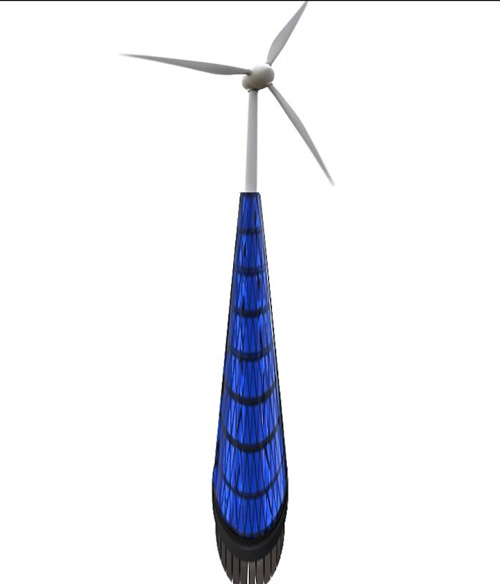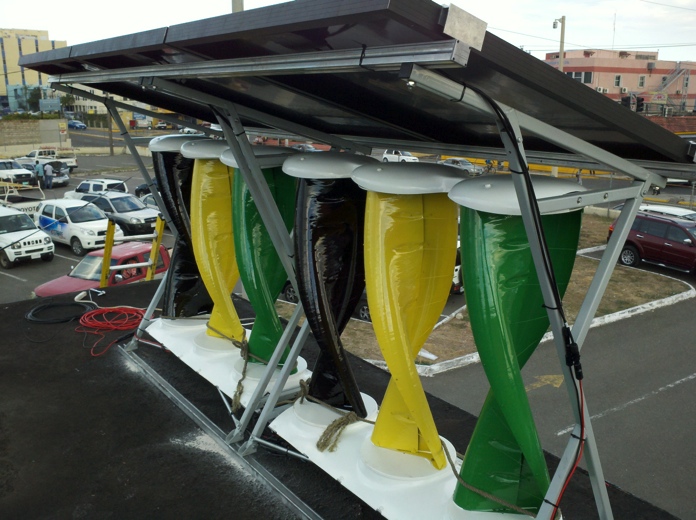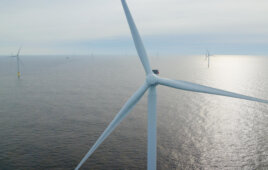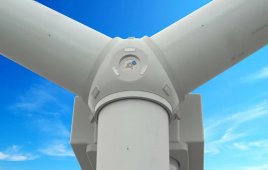
The Solar Panel Windmill is wrapped in modules and shaped as a cone so it doesn’t accumulate snow in the winter. It also has a wind turbine on top to increase power production.
One thing wind turbines have going for them is their capacity to withstand freezing temperatures, especially with the latest in blade de-icing technologies. The same doesn’t hold true for solar panels where even a relatively small amount of snow on top of a panel can seriously impact the energy output of a solar system.
Panel installers often resort to using tilted or angled racking systems in colder climates in hopes the snow won’t stick, but this isn’t always possible or sufficient when dealing with frost or heavy snowfalls. The winter months November through February are still associated with the lowest solar-derived energy per kilowatt-hour readings in many regions.
Even though summer is just around the corner here in North America that hasn’t stopped researchers from investigating different solutions to maximize renewable energy in colder climates. In Ontario, Canada, St Lawrence College’s Sustainable Energy Applied Research Centre is testing a new type of bifacial module that captures sunlight on both sides of a panel. Because the dual-technology essentially doubles the chance of capturing solar rays, these panels also shed snow faster than traditional panels.
This technology is impressive but it doesn’t fully solve the problem of accumulated snowfall, nor does it address the intermittency of the sun. A science student at the University of Calgary, however, has been working on a new hybrid approach that incorporates wind power into the mix. Jaswinder Brar is currently looking for a partner to develop what he calls the Solar Panel Windmill Cone, a solar-based windmill that’s in the shape of a cone.
Made of solar modules, the Solar Panel Windmill Cone is self-heating and water-resistant so that snow slides right off. “The cone configuration leaves minimal surface area for snow to layer on and it offers a space-saving design,” said Brar who pointed out just how much room traditional panels require compared to the Cone. He also said the addition of the windmill serves to boost the generation and consistency of renewable power. “The Windmill Cone can not only thrive in winter conditions, but it can also rely on wind power when the sun isn’t shining.”
Brar makes a good point. Hybrid solutions have been touted for their ability to deal with the inconsistencies of nature: the sun doesn’t always shine nor the wind always blow. But they’re also worth considering in areas where solar or wind energy alone don’t justify investment in either a solar or wind energy system separately, making renewables a viable option for almost anywhere.

A unique hybrid solution, SolarMill offers proprietary Maximum Power Point Tracking (MPPT) electronics that help maximize the generation capabilities of the wind turbines and the solar panels.
For example, WindStream Technologies’ SolarMill is a hybrid system designed for on and off-grid installations using three low-profile vertical-axis wind turbines mounted on a single base with a solar panel on top. The units can be interconnected to increase energy production in low-speed and turbulent wind environments. The system can also overcome weather fluctuations over time, whether it’s for a 24-hour period or a 12-month period. As the company states on their website: “A truly hybrid solution will compensate for seasonal losses of power generation not solely depending on one type of renewable energy system.”
A hybrid solar/wind-powered system might serve as an ideal option for colder climates and, if the findings from a 2013 study from the Reiner Lemoine Institut and Solarpraxis hold true, most any climate warm or cold. These researchers examined the surface area where solar PV systems and wind turbines were installed together and found twice the amount of electricity was generated without negative impacts (such as intermittency issues) on the grid. Even the shadow cast by turbines on the panels (once a commonly held concern because of the lost power production caused by shade) barely made an impact and was found to account for only a 1% to 2% reduction in PV output.
The bottom line: solar-powered systems usually generate more energy in the summer while wind turbines generally produce a lot more electricity during the colder months, and combined, the two systems can significantly increase energy generation. It seems the hybrid technology behind the Solar Panel Windmill Cone and the SolarMill are onto something worth considering regardless of climate.
Filed Under: Projects




